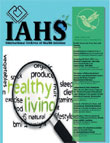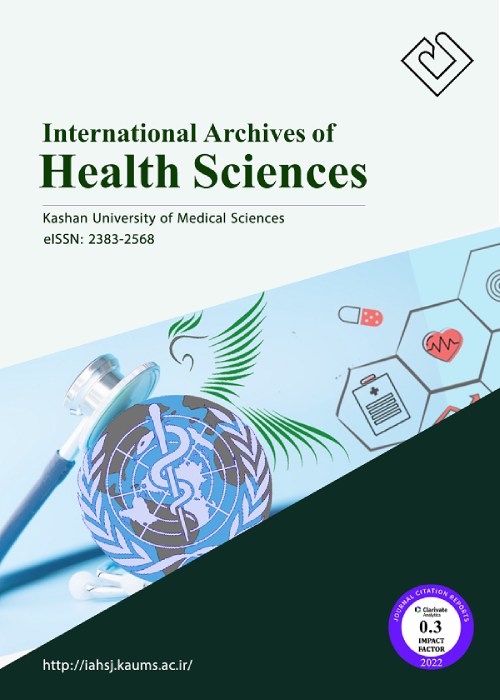فهرست مطالب

International Archives of Health Sciences
Volume:2 Issue: 2, Apr-Jun 2015
- تاریخ انتشار: 1394/05/21
- تعداد عناوین: 6
-
-
Pages 51-55AimsThe effect of electrochemical process on polyphosphate alone has not been yet investigated. The aim of this study was to study polyphosphate removal from synthetic wastewater by electrochemical process.Materials and MethodsThis research was carried out experimentally on 50 samples of synthetic wastewater. In each run 2000ml of SW took place in a batch. A constant 600mA direct current was applied on the batch content through steel electrodes. First synthetic wastewater samples with initial concentrations in the range of 2-16mgL-1-P were examined and one sample was taken every 2min during 12min. Then samples in the range of 2 to 32mgL-1-P were tested and one sample was taken every 10min during 1 hour. Residual phosphorous in taken samples was measured according to Standard Methods book.FindingsThe removal efficiency was 85-99. 85%. Residual phosphorous concentration was reduced below 1mgL-1-P (Iranian standard) in 1. 15mA/cm2 DC. The needed reaction time was 10min. for 2-16mgL-1-P initial concentration whereas at higher concentrations it was 30min. Also، the reaction was first order with respect to the residual phosphorous concentration.ConclusionThis process is efficient for removal of the over 99% of poly phosphate from the wastewater and able to reduce the residual phosphorous in effluent to less than Iranian standard limits for reuse (≤1mgL-1).Keywords: Electrochemical Techniques, Polyphosphates, Waste Water
-
Pages 57-61AimsHeavy metals are the main pollutants in nature. Chromium is a heavy metal which is widely used. Hexavalent chromium solubility and mobility in aqueous solutions is so high and it is easily reduced. Biosorption is a process in which heavy metals are uptake through passive binding by nonliving biomass from aqueous solutions. The present study aimed to determine the capability of powdered Spirogyra to remove chromium from synthetic aqueous solutions under the influence of process parameters includes pH, algal dosage, and metal initial concentration.Materials and MethodsThis study was empirically carried out in laboratory scale through a batch system in Kashan region, Iran, in September 2014. Hexavalent chromium stock solution (500mg/l) was made by solving 1.417g of dichromate potassium in 1 liter of distilled water. The experiments were conducted with initial concentration of 10, 25, and 40mg/l of hexavalent chromium in pH levels equal to 3, 7 and 11 and algal dosages of 0.2, 0.5 and 1g/l. The repeated-measure test was applied for statistical analysis using SPSS 16 software.FindingsMaximum value of chromium removal was observed at pH=3 (70%). Hexavalent chromium removal value increased with increasing algal dosage from 0.2g/l (45%) to 1g/l (70%) in 100ml samples with 40mg/l concentration of Cr(VI). The amount of Cr(VI) bound by unit weight of biomass were increased from the initial concentration of 10 to 40mg/l about 27mg/g in all levels of pH.ConclusionLow dosages of powdered Spirogyra can remove hexavalent chromium from wastewater and aqueous solutions.Keywords: Absorption Physiological, Hexavalent Chromium Ion, Spirogyra, Metals Heavy
-
Pages 63-67AimsDrug addiction is a mental, social, and economic problem that comes from abnormal and illicit consumption of substances such as alcohol, opium, hashish, and etc., making the addict psychologically and physiologically dependent to those substances. This study was designed and performed to evaluate the pattern of drug abuse change in the addicts visiting addiction treatment centers of Kashan City, Iran. Instrument &MethodsThis retrospective descriptive research was performed on 4066 persons referred to addiction treatment and harm reduction therapy centers, monitored by Kashan University of Medical Sciences, during 2004 to 2008. After coding, data were entered into the SPSS 16 software. Chi-square and one-way ANOVA was used to analyze the data.FindingsThe main reasons of the tendency to drugs were not having fun (72.5%), family problems (55%) and not having knowledge (22.7%). The use of opium was the highest in all the years while the crack was used by 7.1% of drug addicts in 2004 and increased to 76% in 2007. 92.8% of drug abuses were through fumigation, 33.7% through injection, 48% orally and 8.6% through inhalants.ConclusionYouths are the most vulnerable age group to drug addiction. Easy access to illegal drugs, wrong friends, and curiosity are of the significant factors spreading drug addiction.Keywords: Behavior Addictive, Substance, Related Disorders, Narcotics
-
Pages 69-74AimsLeishmaniasis is the most prevalent vector- borne parasitic disease in Iran. Drug treatment is the best way to treat leishmaniasis, while the common drugs are not efficient enough and inevitable side effects limit using these drugs. The aim of this study was to analyze in vitro and in vivo activity of the methanolic extract of Artemisia absinthium, Vitex agnus-castus and Phytolaca americana Against Leishmania major.Materials and MethodsThe methanolic extracts of Artemisia absinthium, Vitex agnus-castus and Phytolaca americana were prepared by cold percolation method. The inhibitory concentration 50 (IC50) of the plant extracts was determined against L. major promastigotes followed by efficacy evaluation of the extracts against amastigotes and in vivo assay in the BALB/c animal model. The data was analyzed with SPSS 19 software using Student's T test and ANOVA.FindingsArtemisia absinthium had the highest amount of active compounds against promastigotes of L. major (IC50=159.45) and antiprolifrative activity of Artemisia absinthium on both forms of L. major (extracellular promastigotes and intracellular amastigotes) was the highest (MI=33%). Vitex agnus-castus had the least toxic effect for macrophages (8%). All extracts limited the progression of lesion size versus control group, however, only inhibitory effect of Artemisia absinthium extract was statistically significant.ConclusionArtemisia absinthium is the most effective growth inhibitor of amastigotes in animal lesions and it is safe for drug application in human and animals.Keywords: Leishmaniasis, Leishmania major, Artemisia absinthium, Vitex agnus, castus extract
-
Pages 75-81AimsConsidering the importance of medical waste recognition by health centers staffs and its role on maintenance and improvement of social and environmental health, this study aimed to evaluate the knowledge, attitude and practices of hospital staffs regarding to medical waste management. Instrument &MethodsThe current descriptive, analytical and cross-sectional research was carried out on the staffs of the Ayatollah Rohani Hospital of Babol City, Iran, in 2013. 130 employees were selected by stratified sampling method. A researcher-made questionnaire (accessible as an attachment) containing 4 parts of demographic information, knowledge (15 questions), attitude (6 questions) and practices (6 questions) was used for data gathering. The data was analyzed by SPSS 17 software using Kruskal Wallis and Mann-Whitney tests.FindingsThe participants mean scores of knowledge, attitude, and practice were 10.7±1.6 (out of 15), 5.5±0.8 (out of 6), and 4.5±1.5 (out of 6), respectively. 12% (16 people) of the participants had low, 72% (93 people) of the participants had medium, and 16% (21 people) of them had high knowledge toward hospital waste management. 16% (21 people) of the participants had medium and 84% (109 people) of them had high attitude toward hospital waste management. 4% (5 people), 46% (60 people) and 50% (65 people) of the participants had low, medium and high practice, respectively.ConclusionThe level of knowledge, attitude and practice of the Ayatollah Rohani Hospital of Babol City, Iran, regarding hospital waste management is acceptable.Keywords: Knowledge, Attitude, Medical Staff Hospital, Medical Wastes Disposal, Hospital
-
Efficiency of Removing Chromium from Plating Industry Wastewater using the Electrocoagulation MethodPages 83-87AimsChromium is one of the most important metallic pollutants in plating industry wastewater. This toxic metal is a serious threat to human health and to the environment due to its cumulative effects and non-degradability. This research intended to study the effects of pH, contact time, and voltage on the degree of chromium removal from wastewater of plating industry by using the electrocoagulation method.Materials and MethodsThis laboratory research conducted from late May to late November 2012. A 1000cc reactor at laboratory scale was used that included 4 aluminum electrodes of 90% purity, dimensions of 5 by 10cm, and thickness of 1mm, with parallel arrangement. Synthetic chromium-bearing wastewater was prepared at the initial concentration of 50mg/l. The process is done at pH values of 3, 7, and 9, electric potentials of 20, 30, and 40 volts contact durations of 20, 40, 60, and 80 minutes.FindingsThe degree of chromium reduction did not change linearly with time in the solution and strongly depended on the pH. The efficiency of chromium removal in the samples had an ascending trend with increases in voltage from 20 to 30 and 40 volts. The degree of chromium removal increased at longer contact times.ConclusionLower pH, more contact time and higher voltages are effective factors in the chromium removal from wastewater by coagulation method.Keywords: Industry, Waste Water, Chromium, Electrocoagulation


